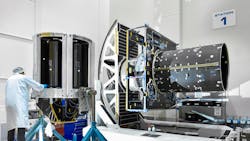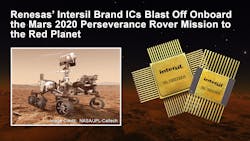Lately there has been a lot of attention paid to the heavens. Specifically, near-Earth space, between Low Earth Orbit (LEO) and Geosynchronous. We recently pointed out in “Money! In! Space!” that there is a business renaissance in space businesses and the related infrastructures. Startups in the space (pun intended) have been expanding old applications, creating new ones, and promising ones over the horizon, from intraorbital satellite taxis to future honeymoon lunar “cruises”.
All of this means that there is a lot of money to be made, and a new marketplace to expand into. Business in space will also drive significant engineering development, in verticals like proconsumer frequent-flyer spacesuits and luxury hotel suite modules created for the space station (or solitary operation). Every solution created for the space (haha), however, must also comply with the most stringent mil/aero operational specifications. This challenge will also be compounded by the need to address consumer needs simultaneously.
In order to get a handle on some of the challenges electronic design engineers will face in the creation and development of space-rated business solutions, we talked to Josh Broline, Director of Marketing Applications for Renesas’ High-Reliability Business Unit (the company formerly known as Intersil). The company has quite a few of its rad-hard ICs onboard NASA's Mars 2020 Perseverance rover.
Josh Broline: Yeah, soft error is on the list, but there's a much bigger list of interrupts, or errors, or even destructive phenomenon that system-level designers have to be aware o,f and design for.
EE: That's why we’re glad to have you here Josh, because it's very easy to think of the knee-jerk stuff like, I’ve got to make sure I protect myself from particle damage, but then there's also ray damage and other aspects, correct?
Josh Broline: I would say, probably the biggest threat from a general space environment, are the heavy ions or single particles coming off of the sun, or from outside of our solar system. Then another subject could be man-made events, nuclear-type events, depending on which avenue you want to go down. But from a natural space-environment perspective, I would say heavy ions or single-event particles would be the bigger challenge.
EE: Interesting, Josh. Now, when you say manmade, I'm assuming you're not talking about, “I've got to make it EMP-proof for the apocalypse”. I think you're talking about stray leakage from radiation-based power systems or something?
Josh Broline: It's the latter, but I would probably want to, for this conversation, lean on the side of the natural environment. Usually you don't have, as far as system-level man-made issues. There's various things that have come up over the years, but usually that's not the bigger concern, as far as outgassing, mechanical, or environmental things, or additional radiation because of what's internal to the systems. That's usually a lower concern from my perspective and understanding.
EE: That’s one of the reasons that we’re really interested in talking to you about this. Space hardware is no longer, to overburden the pun, is no longer just the realm of rocket scientists. We've got prosumer space coming, with tourism, and we've got a lot of microsatellite, and co-satellite, and there are a lot of things going on in near-earth orbit now that are business-oriented, consumer-oriented, but they still have to be mil/aero spec.
Josh Broline: In general, that's a good way to summarize things. They have to look at each individual scenario, whether it's a Virgin Galactic ship that's going to be up there for a couple of hours, or whatever the case may be, at say 330 kilometers roughly, something like that, or at the International Space Station. That's a lot different versus maybe a SpaceX satellite at 550 kilometers, that's going to be up there for five or seven years, and then you certainly can go far beyond that, go all the way up to the high earth orbits in 15- and 20-year missions.
So there's definitely a broadening of the spectrum of different missions and the different things that the engineers, and the folks that are putting these things together, have to consider. So it's a much broader spectrum. Certainly, when you go into space, when you're basically beyond 40,000 feet, you have to start factoring those things in and considering them. Depending on the mission life, depending on your shielding, depending on your mission, as far as what you're trying to achieve, how critical things are within the system, you start developing a model and the requirements case for the various subsystems.
EE: Now, when it comes to say Renesas and the old Intersil, as it were, I mean, let's nod to them as well because I knew that company well, as it were, as we gaze at the skull that has been dug up during the conversation, alas poor Yorick as it were. But the bottom line is, Intersil have put a lot of very good IP into this mix, the whole aspect of designing for space and making something rad-hard. I mean, you're not just putting a lead cap on this stuff or anything. It has to be a fundamental topology issue, isn't it?
Josh Broline: I would say there are four prongs to it at a high level, as far as what goes into it. There's process technology selection, there's the design aspect of it from a schematic perspective, and then there's a layout, the layout of the individual transistors, the devices, and then lastly, how do you screen, and how do you guarantee the part? You got to know the widget that you're trying to put out there, and wrap good specs around it, and have good characterization reports, so the end user can know what they're up against when they select that part.
EE: Touch on all of them a little, if you would not mind.
Josh Broline: Sure and these may be more or less important, depending again, on the end mission across that broad spectrum. With our decades of history, we understand more than, say another company that was just getting into it. So with our background and our institutional knowledge, we understand which processes going into it, for example, like a silicone, an insulator process, that was potentially prone to certain radiation threats, if you will, or concerns.
So we have a very fundamental understanding. Then if we want to go to a cutting-edge process, we understand the technology, we have a general understanding of what we're getting into. Even those may not be SOI-based processes. Maybe they're just straight junction-isolated, versus dialectical-isolated. We can go in, and we can start looking at ways from a design aspect, for example, redundancy, or how we limit the current if these events happen. The designers can start tackling those.
In addition, we'll take that process and we'll take a look at the individual transistor level, just simplifying it for you and saying, "Okay, what modifications,what know-how can we apply to that particular transistor, that ultimately can help us mitigate what are the threshold shifts on a given transistor, or the various radiation effects?" So we can start putting that together. Ultimately, we get that silicon out, we do the best of our ability. We look at the simulator results et cetera, but we actually have to have empirical data, and then we'll go do an extensive amount of characterization and evaluation.
Oftentimes it's not necessarily the fundamental performance that we have to modify. It's that fundamental performance of that integrated circuit, versus what the expectations are from a radiation-environment perspective. So it might have functional interrupts when we do heavy-ion testing, or single-event testing. We may see too big of a shift on a critical parameter, say a reference voltage shift over total-dose radiation.
So we'll go back and oftentimes our redesigns are driven because of the performance of the integrated circuit within that, even though we have a lot of institutional knowledge to throw at it. So, we don't always get it right the first time, and that's the case across the board, I would imagine as well for the various IC suppliers. So, that's a little bit of insight in that.
EE: Now, are there any new issues you have seen that have come up because of the commercialization of space?
Josh Broline: As you go down to the different geometry nodes, for example, companies are starting to get to say 40 or 45 nanometers or below, there are different considerations. You might, because of the smaller geometry and it's packed in more, you can imagine the ion-strike could actually potentially disrupt or damage more circuitry. So there's things that they have to consider there.
Or it may be better from a total-dose perspective, a background-radiation perspective, because the makeup of the gate-oxide thickness, for example, may be more advantageous in that case. So yeah, there's different pros and cons, and our policy at the end of the day is you don't know until you test it, you don't know until you test it.
By and large, even though the spectrum is widening, like you mentioned more so on the commercial side of things, those that are doing it right have that mentality as well. Again, with the backdrop of their mission, and the requirements, and the expectations in the environment that they're going to be flying in. So they have to go and look at each component and where it is in the system. How critical is it? Can we make it redundant if we have to? Or do we have to have that individual component's hardness meet that? Say it's powering an FPGA or powering a processor, well we can't have that go down, it'll kill the mission. So they have to look at that, and as an example, that's where we come in, that's where we specialize.
No matter where they are on the spectrum, they have to consider all of those things. Now you may have, as an example, I don't have a lot of insight on this because they're very tight to the vest, but like a SpaceX, they're doing a lot of things from a software perspective, you're talking about upsets at the beginning, soft-error upsets, single-event offsets, those things can be sometimes taken care of from a software perspective, but you're always going to have hardware and you're always going to have to consider those things.
So either you're relying on a company like us to give you the hardening that you need on a component-by-component basis, or they're doing something from a system-redundant perspective, or a software-scrub perspective, or they don't need it as harsh, if you will, or not needing as harsh environmental requirements, because of their altitude, the orbit, like I said, their mission life, or their tolerance for upsets, or for things that they have to deal with.
EE: The whole aspect of engineering is an understanding of the gestalt. Design has changed a lot in practice, but not in theory. For example, people used to design their own power supply, but they don't design their own supply anymore because it's more efficient and cheaper to buy from a power supply manufacturer. But just because I don't have to design that supply, doesn't mean that I can afford to forget what's important about that supply as it applies to the larger design, for example. Or in the case of a logic circuit, when you're talking rad-hard, even power is intelligent nowadays, so we've got to worry about soft error in the I2C bus, you know what I'm ...
Josh Broline: Yep, yep, or the memory, right?
EE: Exactly. Go ahead.
Josh Broline: So that particular case is an interesting one. Look at a PMBus- or I2C-based, full digital, or with an analog core to it, and you start putting memory and nonvolatile memory in there. You have, like you said, the I2C bus, or you have some registers, that's not an easy solution to all of a sudden fly, because it has a lot of things that you have to consider.
In that particular case, if you're using registers or nonvolatile memory to program critical aspects of that regulator that are going into a critical power supply, say for example, powering a core of the main processor FPGA, you can't necessarily do a lot of real time ECC, or scrub, et cetera on that memory. It's got to work, versus maybe a large bank of memory off of an FPGA, or a processor.
You could probably spend a little more time scrubbing that and doing something with that. So that gets into the heart, yeah. So I can relate to that specifically. As you can't just pour it over a commercial solution into even the less benign, less risky space environment. So a certain level of space radiation hardness, or tolerance is always going to be a backdrop of a value proposition, whether or not the end user, or the ultimate system supplier, values that or not is up to them, depending on what they're ultimately trying to accomplish. They apply it and implement it but nonetheless, the space environment's not changing any anytime soon. So you still have a strong value proposition in this arena.
They can get away with that by qualifying more, and characterizing more at the ground level, as opposed to going into space, where it could be a mission killer and you can't go ... at least today, or the foreseeable future, you can't just send up an astronaut or an individual to go fix it, right? So there's still an ongoing barrier to entry to the space environment, because of the radiation concerns that hopefully everybody is considering.
EE: Very cool, Josh. Before we let you go, are there any final thoughts you wanted to leave with our readers?
Josh Broline: I would just say, we go back to the '50s, a company called Radiation Inc. So we have a strong heritage going back six-plus decades, I should say, 60-plus years we draw from. It will not for the foreseeable future, be an easy market to address, and we bring a lot of institutional knowledge to the table. Like you mention, working in the space environment, that value proposition is not going away anytime soon.
So even though we've gone through our own acquisitions over the years, as Intersil and then being acquired by Renesas, and also Renesas acquiring IDT, Integrated Device Technologies, a couple of years ago, that only brings potential opportunities to expand on what we can do for the system. So we get the opportunity and the privilege to look at satellite systems, or rover systems, et cetera, at that level and we can bring what we can bring to the table. It's a fun way to approach the job and a fun industry to be a part of because there is a lot of neat stuff going on at the high level.
About the Author
Alix Paultre
Editor-at-Large, Electronic Design
An Army veteran, Alix Paultre was a signals intelligence soldier on the East/West German border in the early ‘80s, and eventually wound up helping launch and run a publication on consumer electronics for the US military stationed in Europe. Alix first began in this industry in 1998 at Electronic Products magazine, and since then has worked for a variety of publications in the embedded electronic engineering space. Alix currently lives in Wiesbaden, Germany.
Also check out his YouTube watch-collecting channel, Talking Timepieces.



